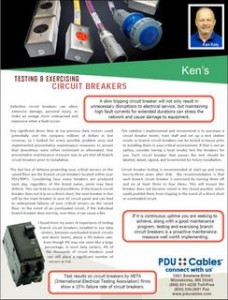KEN'S KORNER - Testing & Exercising Branch Circuit Breakers
Testing and Exercising Branch Circuit Breakers
A slow tripping circuit breaker will not only result in unnecessary disruptions to electrical service, but maintaining high fault currents for extended durations can stress the network and cause damaged to equipment.
Defective circuit breakers can allow extensive damage, personal injury, or make an outage more widespread and expensive when a fault occurs.
Any significant down time at my previous data centers could potentially cost the company millions of dollars in lost revenue, so I looked for every possible problem area and implemented preventative maintenance measures to ensure that downtimes were either minimized or eliminated. One preventative maintenance measure was to pre-test all branch circuit breakers prior to installation.
The last line of defense protecting your critical servers on the raised floor are the branch circuit breakers located within your PDU/RPP's. Considering how many breakers are produced each day, regardless of the brand name, some may have defects. This can lead to several problems. If the branch circuit breaker does not trip on a direct short, the next breaker in line will be the main breaker in your 42 circuit panel and can lead to widespread failures of your critical servers on the raised floor. In the event of an overloaded circuit, if the individual branch breaker does not trip, over time, it can cause a fire.
I found from my years of experience of testing branch circuit breakers installed in our data centers, between overloaded branch circuits and direct shorts, about a 4% failure rate. Even though 4% may not seem like a large percentage, in most data centers, 4% of the thousands of circuit breakers used can still place a significant number of servers at risk.
The solution I implemented and recommend is to purchase a circuit breaker tester, train staff and set up a test station onsite so branch circuit breakers can be tested in-house prior to installing them in your critical environment. If that is not an option, consider having a local vendor test the breakers for you. Each circuit breaker that passes the test should be labeled, dated, signed, and inventoried for future installation.
Circuit breaker testing is recommended at start-up and every two-to-three years after that. My recommendation is that each branch circuit breaker is exercised by turning them off and on at least three to four times. This will ensure the breaker does not become seized in the closed position which could prohibit them from tripping in the event of a direct short or overloaded circuit.
Circuit breakers, if installed within their ratings and properly maintained, should operate trouble free for many years. Circuit breakers not properly maintained within a 5-year period have a 50% failure rate.
• Circuit breakers are often forgotten, and most commonly fail due to inactivity. A burned out trip coil, dirt, hardened grease, corrosion, misalignment or frozen or broken parts that prevent operation can all cause a breaker to fail.
• Molded case circuit breakers are only rated for 1 to 3 full faults. When a circuit breaker trips there is a risk if the short circuit still exists.
• There is no way to know if a circuit breaker will operate properly under fault or overload conditions unless it is tested.
• Circuit breakers that have tripped should be investigated, as well as the load they are supporting, before resetting.
• If the circuit breaker is older or has tripped previously consider replacing it.
• Proper exercising of breaker mechanisms includes removing the breaker from service and testing over-current and short-circuit tripping capabilities.
• The process of resetting a circuit breaker multiple times before investigating it should not be allowed.
• Circuit breakers should be kept clean, if dirt accumulates on the surround of the breaker, the heat build-up may not dissipate properly resulting in nuisance tripping.
• A circuit breaker that fails to open under fault can result in fires, damage to equipment or injuries to personnel. Stiff or sticky circuit breakers can cause an unintentional time delay and increase the chance for an arc/flash incident.
• Circuit breakers, circuits and equipment should be inspected and tested by a qualified person.
Remember, circuit breakers are cheap compared to the equipment and people they are intended to protect. Whenever there is any doubt about a circuit breaker, replace it.
Manually Exercising Circuit Breakers
• Helps to keep contacts clean through their wiping action
• Ensures that the operating mechanism moves freely
• Avoids operating the tripping mechanism
If it is continuous uptime you are seeking to achieve, along with a good maintenance program, testing and exercising branch circuit breakers is a proactive maintenance measure well worth implementing.
Ken Koty
For additional information on testing circuit breakers, here are a couple great sources.
http://www.relectric.com/circuit-breaker-tips/how-to-test-a-circuit-breaker.html
http://www.netaworld.org/sites/default/files/public/neta-journals/CurrentMethod-Pg19-22.f.pdf

